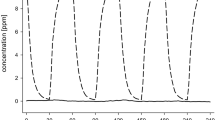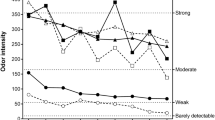Abstract
Objective
Aim of the study was to examine possible chemosensory effects of ε-caprolactam in the low concentration range relevant to indoor environmental conditions.
Methods
Twenty healthy subjects (10 male, 10 female) aged from 21 to 38 years were exposed for 6 h, respectively, to 0, 0.15, 0.5 and 5 mg/m3 ε-caprolactam vapours in a randomized and double-blind method. As a measure of trigeminal stimulation of the eye, blink frequency was video-recorded four times per day and evaluated by using a new semi-automatic, computer-assisted method compared to baseline recording and manual counting. Digital slit lamp photographs were taken at the same time to examine conjunctival hyperaemia. A standardized ophthalmologic grading scale was used to measure redness of the eyes objectively. Active anterior rhinomanometry compared nasal resistance before and after exposure. Subjective ratings of discomfort and mental orientation were assessed using the German version of the Swedish Performance Evaluation system (SPES). As a measure of personality traits, positive and negative affectivity was determined (PANAS).
Results
Six hour exposures to ε-caprolactam revealed no significant dose–response relationship concerning blink frequency, nasal resistance and redness of the bulbar conjunctiva. Subjective ratings of discomfort (sum scores) significantly increased only at the highest concentration of 5 mg/m3. However, the increase in discomfort was only moderate, ranging between “not at all” and “somewhat”. Significant increases of the subjective detection of malodour (subscore) already occurred at 0.15 mg/m3, showing no adaptation over time. Irritation of the eyes or upper airways was not reported.
Conclusions
Exposure to ε-caprolactam vapour did not elicit any acute health effects in a concentration range up to 0.5 mg/m3. Even at the highest concentration of 5 mg/m3, we could only find a slight increase in subjective symptoms, mainly due to an unincisive increase of perception of malodour.






Similar content being viewed by others
References
Al-Abdulmunem M (1999) Relation between tear breakup time and spontaneous blink rate. Int Lens Clin 26:117–120
Arts JH, de Heer C, Woutersen RA (2006) Local effects in the respiratory tract: relevance of subjectively measured irritation for setting occupational exposure limits. Int Arch Occup Environ Healh 79(4):283–298
Carmen Acosta M, Gallar J, Belmonte C (1999) The influence of eye solutions on blink and ocular comfort at rest and during work at video display terminals. Exp Eye Res 68:663–669
Cometto-Muniz JE, Cain WS (1991) Influence of airborne contaminants on olfaction and the common chemical sense. In: Getchell TV, Doty RL, Bartoshuk LM, Snow JB (eds) Smell and taste in health and disease. Raven Press, New York, pp 765
Dalton P (1999) Cognitive influences on health symptoms from acute chemical exposure. Health Psychol 18(6):579–590
Dalton PH, Dilks DD, Banton MI (2000) Evaluation of odor and sensory irritation thresholds for methyl isobutyl ketone in humans. J AIHA 61(3):340–350
Deutsche Forschungsgemeinschaft (DFG) (2006) List of MAK and BAT Values 2006. Report 42, pp 9 and 13. ©2006 Wiley-VCH Verlag GmbH&Co.KGaA, Weinheim. ISBN-10: 3527–315993
Doty RL, Cometto-Muniz JE, Jalowayski AA, Dalton P, Kendal-Reed M, Hodgson M (2004) Assessment of upper respiratory tract and ocular irritative effects of volatile chemicals in humans. Crit Rev Toxicol 34(2):85–142
Dunn JD, Cometto-Muñiz JE, Cain WS (1982) Nasal reflexes: reduced sensitivity to CO2 irritation in cigarette smokers. J Appl Toxicol 2:176
Emmen HH, Muijser H, Arts JHE, Prinsen MK (2003) Human volunteer study with PGME: eye irritation during vapour exposure. Toxicol Lett 140–141:249–259
Ferguson WS, Wheeler DD (1973) Caprolactam vapor exposures. Am Ind Hyg Assoc J 43(9):384–389
Gamberale F (1989) Critical issues in the study of the acute effects of solvent exposure. Neurotoxicol Teratol 11(6):565–570
Goldblatt MW, Farquharson ME, Benett G, Askew BM (1954) Epsilon-Caprolactam. Br J Ind Med 11(1):1–10
Greim H (2004) Toxikologisch-arbeitsmedizinische Begründung von MAK-Werten. Senats-komission zur Prüfung gesundheitlicher Arbeitsstoffe. Wiley-VCH, Weinheim
Gross P (1984) Biologic activity of epsilon-caprolactam. Crit Rev Toxicol 13(3):205–216
Hempel–Jorgensen A, Kjaergaard SK, Molhave L (1998) Cytological changes and conjunctival hyperemia in relation to sensory eye irritation. Int Arch Occup Environ Health 71:225–235
Hohensee F (1951) Über die pharmakologische und physiologische Wirkung des Epsilon-Caprolactam. Faserforschung Textiltechnik 08:300–303
Ihrig A, Hoffmann J, Triebig G (2005) Examination of the influence of personal traits and habituation on the reporting of complaints at experimental exposure to ammonia. Int Arch Occup Environ Health 79(4):332–338
Iregren A, Gamberale F, Kjellberg A (1996) SPES: a psychological test system to diagnose environmental hazards. Swedish Performance Evaluation System. Neurotoxicol Teratol 18(4):485–491
Karson CN (1988) Physiology of normal and abnormal blink. Adv Neurol 49:25–37
Kelman GR (1986) Effects of human exposure to atmospheric epsilon-caprolactam. Hum Toxicol 5(1):57–59
Kiesswetter E, van Thriel C, Schäper M, Blaszkewicz M, Seeber A (2005) Eye blinks as an indicator for sensory irritation during constant and peak exposures to 2-ethylhexanol. Environ Toxicol Pharmacol 19(3):531–541
Kleno J, Wolkoff P (2004) Changes in eye blink frequency as a measure of trigeminal stimulation by exposure to limonene oxidation products, isoprene oxidation products and nitrate radicals. Int Arch Occup Environ Health 77(4):235–243
Klimek L, Hundorf I, Delank KW, Hörmann K (2002) Assessment of rhinological parameters for evaluating the effects of airborne irritants to the nasal epithelium. Int Arch Occup Environ Health 75(5):291–297
Krichevskaya IM. Gig. i Sanit. 1968 (1):22 (Article in Russian: cit. in Gross 1984.)
Monster AW, Chan HC, O’Connor D (1978) Long-term trends in human eye blink rate. Biotelemetry Pat Monit 5:206–222
Naumann HH (1990) Nase, Nasennebenhöhlen und Nasenrachen. In: Differentialdiagnostik in der Hals- Nasen-, Ohrenheilkunde. Georg Thieme Verlag Stuttgart, New York, pp 176–230
Nojgaard JK, Christensen KB, Wolkoff P (2005) The effects on human eye blink frequency of exposure to limonene oxidation products and methacrolein. Toxicol Lett 156(2):241–251
Norn MS (1992) Diagnosis of dry eye. In: Lemp MA, Marquardt R (eds) The dry eye—a comprehensive guide. Springer, Berlin, pp 134
Paustenbach DJ, Gaffney SH (2005) The role of odor and irritation, as well as risk perception, in the setting of occupational exposure limits. Int Arch Occup Environ Health 79(4):339–342
Reinhold RW, Hoffman GM, Bolte HF, Rinehart WE, Rusch GM, Parod RJ, Kayser M (1998) Subchronic inhalation toxicity study of caprolactam (with a 4-week recovery) in the rat via whole-body exposures. Toxicol Sci 44(2):197–205
Seeber A, Bolt HM, Gelbke HP, Miksche L, Pawlik K, Rüdiger HW, Triebig G, Ziegler-Skylakakis (1997) Verhaltenstoxikologie und MAK-Grenzwertfestlegungen. Wiley-VCH, Weinheim
Seeber A, van Thriel C, Haumann K, Kiesswetter E, Blaszkewicz M, Golka K (2002) Psychological reactions related to chemosensory irritation. Int Arch Occup Environ Health 75(5):314–325
Shusterman DJ, Murphy MA, Balmes JR (2001) The influence of sex, allergic rhinitis, and test system on nasal sensitivity to airborne irritants: a pilot study. Environ Health Perspect 109(1):15–19
Tsubota K, Hata S, Okusawa Y, Egami F, Ohtsuki T, Nakamori K (1996) Quantitative videographic analysis of blink in normal subjects and patients with dry eye. Arch Ophthalmol 114(6):715–720
Tuma SN, Orson F, Fossella FV, Waidhofer W (1981) Seizures and dermatitis after exposure to caprolactam. Arch Intern Med 141(11):1544–1545
Van Thriel C, Triebig G, Bolt HM (2006) Editorial: evaluation of chemosensory effects due to occupational exposures. Int Arch Occup Environ Health 79(4):265–267
Waddell WJ, Marlowe C, Friedman MA (1984) The distribution of [14C]Caprolactam in male, female and pregnant mice. Food Chem Toxicol 22(4):293–303
Watson D, Clark LA, Tellegen A (1988) Development and validation of brief measures of positive and negative affect: The PANAS scales. J Pers Soc Psychol 54:1061–1070
Wolffsohn JS (2004) Incremental nature of anterior eye grading scales determined by objective image analysis. Br J Ophthalmol 88(11):1434–1438
Wysocki CJ, Cowart BJ, Radil T (2003) Localizing inhaled stimuli: a normative study of nasal-trigeminal chemosensitivity. Percept Psychophys 65:115
Zwierzchowski Z, Kowalski S, Szendzikowski S, Slusarczyik-Zalobna (1967) Medycyna Pracy XVIII 4:357(Article in Russian; English abstract)
Acknowledgments
We would like to thank the International Bureau for the Standardization of Man-made Fibres (BIFSA) in Brussels, Belgium for the financial support of the study. There were no competing financial interests among the authors. Grateful thanks also to Dr. Sylvana Mueller for statistics and Thomas Krczal for the excellent performance of the chemical analyses. The authors gratefully acknowledge the volunteers for their participation.
Author information
Authors and Affiliations
Corresponding author
Rights and permissions
About this article
Cite this article
Ziegler, A.E., Zimmer, H. & Triebig, G. Exposure study on chemosensory effects of ε-caprolactam in the low concentration range. Int Arch Occup Environ Health 81, 743–753 (2008). https://doi.org/10.1007/s00420-007-0264-2
Received:
Accepted:
Published:
Issue Date:
DOI: https://doi.org/10.1007/s00420-007-0264-2




